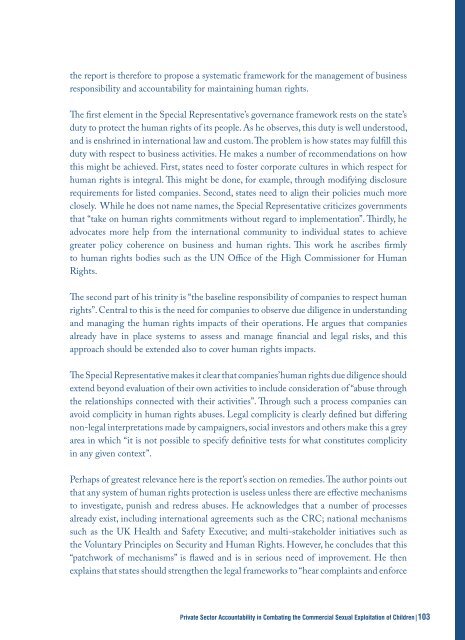to download the document in PDF format - Child Centre: Expert ...
to download the document in PDF format - Child Centre: Expert ...
to download the document in PDF format - Child Centre: Expert ...
Create successful ePaper yourself
Turn your PDF publications into a flip-book with our unique Google optimized e-Paper software.
<strong>the</strong> report is <strong>the</strong>refore <strong>to</strong> propose a systematic framework for <strong>the</strong> management of bus<strong>in</strong>essresponsibility and accountability for ma<strong>in</strong>ta<strong>in</strong><strong>in</strong>g human rights.The first element <strong>in</strong> <strong>the</strong> Special Representative’s governance framework rests on <strong>the</strong> state’sduty <strong>to</strong> protect <strong>the</strong> human rights of its people. As he observes, this duty is well unders<strong>to</strong>od,and is enshr<strong>in</strong>ed <strong>in</strong> <strong>in</strong>ternational law and cus<strong>to</strong>m. The problem is how states may fulfill thisduty with respect <strong>to</strong> bus<strong>in</strong>ess activities. He makes a number of recommendations on howthis might be achieved. First, states need <strong>to</strong> foster corporate cultures <strong>in</strong> which respect forhuman rights is <strong>in</strong>tegral. This might be done, for example, through modify<strong>in</strong>g disclosurerequirements for listed companies. Second, states need <strong>to</strong> align <strong>the</strong>ir policies much moreclosely. While he does not name names, <strong>the</strong> Special Representative criticizes governmentsthat “take on human rights commitments without regard <strong>to</strong> implementation”. Thirdly, headvocates more help from <strong>the</strong> <strong>in</strong>ternational community <strong>to</strong> <strong>in</strong>dividual states <strong>to</strong> achievegreater policy coherence on bus<strong>in</strong>ess and human rights. This work he ascribes firmly<strong>to</strong> human rights bodies such as <strong>the</strong> UN Office of <strong>the</strong> High Commissioner for HumanRights.The second part of his tr<strong>in</strong>ity is “<strong>the</strong> basel<strong>in</strong>e responsibility of companies <strong>to</strong> respect humanrights”. Central <strong>to</strong> this is <strong>the</strong> need for companies <strong>to</strong> observe due diligence <strong>in</strong> understand<strong>in</strong>gand manag<strong>in</strong>g <strong>the</strong> human rights impacts of <strong>the</strong>ir operations. He argues that companiesalready have <strong>in</strong> place systems <strong>to</strong> assess and manage f<strong>in</strong>ancial and legal risks, and thisapproach should be extended also <strong>to</strong> cover human rights impacts.The Special Representative makes it clear that companies’ human rights due diligence shouldextend beyond evaluation of <strong>the</strong>ir own activities <strong>to</strong> <strong>in</strong>clude consideration of “abuse through<strong>the</strong> relationships connected with <strong>the</strong>ir activities”. Through such a process companies canavoid complicity <strong>in</strong> human rights abuses. Legal complicity is clearly def<strong>in</strong>ed but differ<strong>in</strong>gnon-legal <strong>in</strong>terpretations made by campaigners, social <strong>in</strong>ves<strong>to</strong>rs and o<strong>the</strong>rs make this a greyarea <strong>in</strong> which “it is not possible <strong>to</strong> specify def<strong>in</strong>itive tests for what constitutes complicity<strong>in</strong> any given context”.Perhaps of greatest relevance here is <strong>the</strong> report’s section on remedies. The author po<strong>in</strong>ts outthat any system of human rights protection is useless unless <strong>the</strong>re are effective mechanisms<strong>to</strong> <strong>in</strong>vestigate, punish and redress abuses. He acknowledges that a number of processesalready exist, <strong>in</strong>clud<strong>in</strong>g <strong>in</strong>ternational agreements such as <strong>the</strong> CRC; national mechanismssuch as <strong>the</strong> UK Health and Safety Executive; and multi-stakeholder <strong>in</strong>itiatives such as<strong>the</strong> Voluntary Pr<strong>in</strong>ciples on Security and Human Rights. However, he concludes that this“patchwork of mechanisms” is flawed and is <strong>in</strong> serious need of improvement. He <strong>the</strong>nexpla<strong>in</strong>s that states should streng<strong>the</strong>n <strong>the</strong> legal frameworks <strong>to</strong> “hear compla<strong>in</strong>ts and enforcePrivate Sec<strong>to</strong>r Accountability <strong>in</strong> Combat<strong>in</strong>g <strong>the</strong> Commercial Sexual Exploitation of <strong>Child</strong>ren|103




